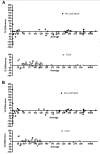Evaluation of an easy and affordable flow cytometer for volumetric haematopoietic stem cell counting
- PMID: 24887218
- PMCID: PMC4111825
- DOI: 10.2450/2014.0198-13
Evaluation of an easy and affordable flow cytometer for volumetric haematopoietic stem cell counting
Abstract
Background: Accurate estimation of haematopoietic stem cell (HSC) counts by flow cytometry may be difficult in laboratories in which sophisticated equipment and staff with specific expertise are not available. Affordable flow cytometers that can perform basic functions may help to overcome these difficulties. In this study we compared HSC and leucocyte counts determined by volumetric and bead-based protocols performed with the small, low-cost Accuri(®) C6, with those obtained with two gold-standard instruments, the four-colour FACSCalibur(®) and the eight-colour FACSCantoII(®), our reference flow cytometers.
Materials and methods: With the three cytometers we tested, in parallel, 111 consecutive samples from cord blood, peripheral blood from patients with myelofibrosis and myeloproliferative syndromes, fresh and thawed HSC collected by apheresis and bone marrow products. The findings were compared with one-way ANOVA, Bland-Altman analysis and linear regression.
Results: The results of HSC and leucocyte enumeration by the three devices were strongly correlated (r(2)>0.99; p<0.0001). ANOVA performed on different subgroups of samples did not reveal significant differences between HSC count determined by the C6 bead-based and reference flow cytometers in any of the subgroups. Regarding the C6 volumetric protocol, a statistically significant difference was observed only in the cord blood subgroup. Time for instrument set-up, calibration and analysis was slightly longer with Accuri(®) C6 (40 min) than with FACSCantoII(®) (30 min).
Discussion: Accuri(®) C6 is a reliable instrument for HSC enumeration in fresh samples, using both volumetric and bead-based approaches, although the volumetric protocol on cord blood samples needs to be improved. The Accuri(®) C6 is easy to use, does not require profound knowledge of flow cytometry and could be employed in an urgent setting. Its performance may be improved by more efficient calibration and shorter analysis time.
Figures
Similar articles
-
Validation of a single-platform method for hematopoietic CD34+ stem cells enumeration according to accreditation procedure.Biomed Mater Eng. 2015;25(1 Suppl):27-39. doi: 10.3233/BME-141226. Biomed Mater Eng. 2015. PMID: 25538053
-
Platelet counting with the BD Accuri(TM) C6 flow cytometer.Platelets. 2014;25(3):175-80. doi: 10.3109/09537104.2013.801947. Epub 2013 Jun 17. Platelets. 2014. PMID: 23772865
-
Affordable CD4(+)-T-cell counting by flow cytometry: CD45 gating for volumetric analysis.Clin Diagn Lab Immunol. 2002 Sep;9(5):1085-94. doi: 10.1128/cdli.9.5.1085-1094.2002. Clin Diagn Lab Immunol. 2002. PMID: 12204964 Free PMC article.
-
Role of flow cytometry in evaluation of the cellular therapy products used in haematopoietic stem cell transplantation.Int J Lab Hematol. 2022 Jun;44(3):446-453. doi: 10.1111/ijlh.13849. Epub 2022 Apr 13. Int J Lab Hematol. 2022. PMID: 35419954 Review.
-
Application of flow cytometric techniques to veterinary clinical hematology.Vet Clin Pathol. 2002;31(2):72-82. doi: 10.1111/j.1939-165x.2002.tb00284.x. Vet Clin Pathol. 2002. PMID: 12040489 Review.
Cited by
-
A Novel Reporter Phage To Detect Tuberculosis and Rifampin Resistance in a High-HIV-Burden Population.J Clin Microbiol. 2015 Jul;53(7):2188-94. doi: 10.1128/JCM.03530-14. Epub 2015 Apr 29. J Clin Microbiol. 2015. PMID: 25926493 Free PMC article.
-
Regulator of G protein signaling 1 suppresses CXCL12-mediated migration and AKT activation in RPMI 8226 human plasmacytoma cells and plasmablasts.PLoS One. 2015 Apr 21;10(4):e0124793. doi: 10.1371/journal.pone.0124793. eCollection 2015. PLoS One. 2015. PMID: 25897806 Free PMC article.
-
Short-term ex-vivo exposure to hydrogen sulfide enhances murine hematopoietic stem and progenitor cell migration, homing, and proliferation.Cell Adh Migr. 2020 Dec;14(1):214-226. doi: 10.1080/19336918.2020.1842131. Cell Adh Migr. 2020. PMID: 33135550 Free PMC article.
-
Relationship between the Peroxidation of Leukocytes Index Ratio and the Improvement of Postprandial Metabolic Stress by a Functional Food.Oxid Med Cell Longev. 2016;2016:5630985. doi: 10.1155/2016/5630985. Epub 2015 Dec 28. Oxid Med Cell Longev. 2016. PMID: 26962396 Free PMC article. Clinical Trial.
-
Comparison of Volumetric and Bead-Based Counting of CD34 Cells by Single-Platform Flow Cytometry.Cytometry B Clin Cytom. 2019 Nov;96(6):508-513. doi: 10.1002/cyto.b.21773. Epub 2019 Feb 20. Cytometry B Clin Cytom. 2019. PMID: 30790450 Free PMC article.
References
-
- Copelan E. Haematopoietic stem cell transplantation. New Engl J Med. 2006;354:1813–26. - PubMed
-
- Ljungman P, Urbano-Ispizua A, Cavazzana-Calvo M, et al. Allogeneic and autologous transplantation for haematological diseases, solid tumors and immune disorders: definition and current practice in Europe. Bone Marrow Transplant. 2006;37:439–49. - PubMed
-
- Keeney M, Chin-Yee I, Weir K, et al. Single platform flow cytometric absolute CD34+ cell counts based on the ISHAGE guidelines. International Society of Hematotherapy and Graft Engineering. Cytometry. 1998;34:61–70. - PubMed
-
- Sutherland DR, Nayyar R, Acton E, et al. Comparison of two single-platform ISHAGE-based CD34+ enumeration protocols on BD FACSCalibur and FACSCanto flow cytometers. Cytotherapy. 2009;11:595–605. - PubMed
-
- Bland JM, Altman DG. Statistical methods for assessing agreement between two methods of clinical measurement. Lancet. 1986;1:307–10. - PubMed
MeSH terms
LinkOut - more resources
Full Text Sources
Medical

